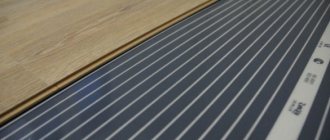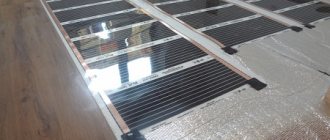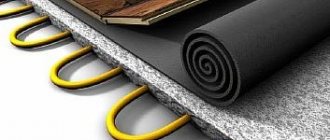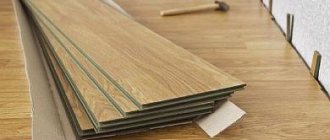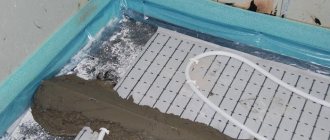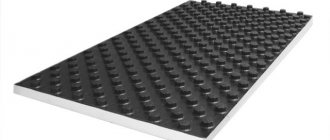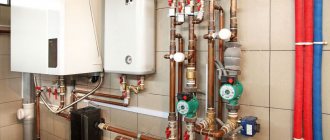Features of wooden floor:
- Less load on load-bearing structures - in some cases there are restrictions on the maximum load on load-bearing structures and the weight of the floor, and it is not possible to organize a cement-sand screed (its weight is approximately 1400 kg/10 m2). In this case, a wooden floor is the solution to the problem.
- Wood requires better thermal and waterproofing
- Wooden floors have a high fire hazard
- Wooden floors are more susceptible to deterioration and rotting
Therefore, when organizing its heating, a wooden floor is subject to increased demands both on the heating element itself and on the installation technology. One of the most popular heating systems for wooden floors is electric heating.
On a wooden base, the easiest way is to use film or cable (heating mats or sections of universal heated floors that do not require laying in a screed).
Film heated floor Teplotex-0.5
- Specific power: 220 W/m2
- Purpose: floor heating
- Country of origin: South Korea
- Heating type: basic / comfortable
- Max. temperature (operating): 45 °C
- Cutting pitch: 25 cm
285 rub. / m
Heating mat Gulfstream MGS2 (0.5 m²)
- Total system power: 75 W
- Linear power: 14 W/m.p.
- Purpose: floor heating
- Country of origin: South Korea
- Heating type: comfortable
- Screen: aluminum foil
RUB 15,500 / PC
Warm floor Oasis (0.5 m²-0.9 m², 100 W)
- Total system power: 100 W
- Linear power: 14 W/m.p.
- Purpose: greenhouse heating / floor heating
- Country of origin: South Korea
- Heating type: comfortable / basic
- Screen: aluminum foil + copper wire drain core
1,700 rub. / PC
Advantages of electric heated floors
- Low cost and ease of installation compared to installing water heated floors or a water heating system. The cost of convectors (especially energy-saving ones) is quite high, but if you evaluate the payback period of such a system, the benefits are relative.
- Efficient use of thermal energy, as a warm floor warms the room from bottom to top. This is especially important for large areas, since convectors distribute heat unevenly.
- Located under the floor, it does not take up space (which is important in small rooms) and does not spoil the interior of the room.
- The system is easy to repair or change, since the installation of an electric heated floor does not imply changes to the design of the wooden base.
- Doesn't burn oxygen.
Suitable types of linoleum
According to popular belief, linoleum is a thin vinyl material that contains more chemical elements. But this is not true.
In total, today the construction market offers customers five varieties of this flooring:
- Natural. This type is an environmentally friendly material. It also has a huge service life and a high level of fire resistance.
- PVC floor covering. Most often, people buy this particular material because of its cheap cost. This type is not particularly suitable for heated floors. When the surface heats up, an unpleasant odor will appear in the room.
- Alkyd. This linoleum has a fabric base. Has excellent thermal insulation characteristics. However, there is a significant drawback - after a certain period of time, due to heating or mechanical influences, the product undergoes deformation.
- Nitrocellulose. It consists of one layer and has moisture-resistant characteristics. But there is also a minus - a low level of fire resistance.
- Rubber. It consists of two layers. The composition of this material includes bitumen, rubber, synthetics. Rubber linoleum is rarely used in residential buildings.
According to a brief description of all varieties of this flooring, not all are suitable for heated floors. The best option is the first type - natural. The use of vinyl linoleum (PVC) is allowed. Other types are not suitable for the heating system.
Let's take a closer look at the first two types.
Natural linoleum
If you can afford to buy it, then opt for it. This product contains only natural elements of nature, namely flax oil, pine resin, crushed cork, lime powder, and natural dyes. It follows from this that this variety, when heated, will not be able to release substances that could be harmful to human health.
This is the main advantage over other types, but not the last. Another distinctive feature is that the material is not deformable during heating or mechanical stress. "Marmoleum" has a high level of fire resistance. It can be exposed to direct sunlight, but natural linoleum will not lose its original appearance.
Linoleum PVC
Otherwise called vinyl linoleum. The natural look is not sold everywhere like vinyl flooring. Choose PVC if you are unable to find natural ones.
This type is divided into separate types:
- domestic;
- commercial,
- semi-commercial.
For residential premises it is recommended to use the last two types. Because they have a higher level of stability and a longer service life. Do not use a product that has a thermal insulating base, because it will serve as an obstacle to the penetration of heat into the room. Heating elements in this case will be useless.
The material must have a fabric base. Don't forget that the vinyl product is made of synthetics, so after the initial heating there may be an unpleasant odor. But after about a month it will disappear.
Might be interesting
Infrared film heated floor on a wooden base
In wooden houses, linoleum or laminate is most often used as flooring - the best option in this case would be infrared film heated flooring.
Characteristics of heating film:
| Laying | Under linoleum, laminate, parquet |
| Heating type | Basic, comfortable |
| Power density | 220 W/m |
| Voltage | 220 volt |
| Max. working t | 45°C |
| Max. t exposure | 60°C |
| Cutting step | 25 cm |
| Thickness | 0.34 mm |
| Width | 0.5/0.8/1.0 m |
The properties of the heating film allow you to organize safe, economical heating of a wooden floor. When installing infrared film, a “dry” installation method is used, which fits perfectly with a wooden floor, because on a wooden base, it is impractical to perform work on pouring a screed or a layer of tile adhesive.
Installation time varies depending on the complexity of the object and the professionalism of the installation team from 2 hours to 1 day.
Calculation of IR film and power
Kits of materials required for installing heated floors include all contacts, wires, insulating terminals, temperature sensors and thermostats necessary for installation. But, before you go to the store to buy infrared film, you will need to make simple calculations related to determining the amount of film needed to lay a heated floor, and calculate the power of the heating elements that will be used during operation.
The area of the film must be at least 70% of the area of the room. The irrational use of expensive material can be avoided by the fact that infrared film is available in three widths: 500, 800 and 1000 mm. It can be cut in length by linear meters along specially marked lines.
In addition to roll film, there is another type of IR film of the zebra system. This is also a polymer film 1 mm thick, but consisting of many panels independent of each other, measuring 500x600 mm. There are 50 such panels in one set, which allows you to install a heated floor on an area of 15 m2. The advantage of such a system is that if one heating element fails, the entire system continues to function properly. With a warranty period of 25 years, it is a very economical and reliable means of installing heated floors under laminate or linoleum.
After connecting all the heating elements and reliable sealing of the connecting terminals with bitumen insulators, a temperature sensor is installed, which must be placed in a plastic container, and a wall-mounted thermostat unit, with which you will regulate the heating of the floor.
It should be remembered that if the power of the film heater you installed exceeds 2.2 kW, and the current in the system is more than 10 A, then you cannot connect it directly to the apartment’s electrical network. In this case, a modular contactor is used. But you should not carry out the installation work yourself. It is better to contact a professional electrician.
Features of installing film heated floors on a wooden base
The basic rules for laying a heated film floor are given in its installation instructions (layout, materials, connections, components). This article lists the features of installing infrared film on a wooden base.
Film heated floors are laid on a wooden floor in two ways:
Laying film flooring between joists
In this case, the film floor is laid on foil thermal insulation placed on the insulating material. In some cases, the film floor is laid directly on the insulation without using a foil backing.
To ensure free passage of air and eliminate mechanical load on the film, the distance between the thermal film and the subfloor must be at least 30mm. All connections are made in compliance with electrical safety standards and regulations.
This installation method increases the electrical and fire safety of the heating system, since the heating element does not come into contact with the upper layers of the floor covering “pie”.
Laying film flooring on a flat base
The installation rules coincide with the general requirements for laying infrared film. Foil thermal insulation is laid on the base of the floor (plywood, OSB, GVL), then thermal film is laid and covered with polyethylene. Finally, a decorative floor covering (laminate or parquet board) is installed.
Important! When laying a film heated floor on a wooden surface, it is necessary to exclude any differences in height, that is, the surface must be smooth and clean (without construction debris) both above and below the TP.
Attention! To lay a film floor under linoleum, a sheet of plywood 2-3mm thick is laid between it and the polyethylene film to protect the thermal film from mechanical damage.
pros
It must be taken into account that this method of installation (directly on a flat base of the floor) makes the system more efficient in terms of heat transfer, since in this case the film floor is in direct contact with the surface of the floor covering and there is no need to heat the air gap between the film and the subfloor as in the first installation method. In addition, during repairs and dismantling you will not have to open the base of the floor.
Minuses
Among the disadvantages of this installation method, it should be noted that it is necessary to make recesses in the layer of foil thermal insulation (and in some cases in the rough field) for the terminal connections of the supply wire with thermal film.
To ensure electrical safety of the heating system, it is necessary to strictly follow the installation and operating instructions for film heated floors.
Film heated floor Teplotex-0.5
- Specific power: 220 W/m2
- Purpose: floor heating
- Country of origin: South Korea
- Heating type: basic / comfortable
- Max. temperature (operating): 45 °C
- Cutting pitch: 25 cm
285 rub. / m
Film heated floor Teplotex-0.8
- Specific power: 220 W/m2
- Purpose: floor heating
- Country of origin: South Korea
- Heating type: basic / comfortable
- Max. temperature (operating): 45 °C
- Cutting pitch: 25 cm
395 rub. / m
Film heated floor Teplotex-1.0
- Specific power: 220 W/m2
- Purpose: floor heating
- Country of origin: South Korea
- Heating type: basic / comfortable
- Max. temperature (operating): 45 °C
- Cutting pitch: 25 cm
455 rub. / m
Is heating compatible with laminate flooring?
Although laminate is positioned in advertising as a wooden covering, in fact it is a multi-layer “pie” made of a protective film, paper impregnated with various resins, and a base - a slab of compressed sawdust. Therefore, the issue of security is really relevant.
When heated, resin and glue release phenol, phthalate, toluene, the infamous formaldehyde and other toxic substances that negatively affect our health.
When choosing a laminate, be sure to pay attention to its emission class and thickness, because a thin flooring of 21-23 mm is better suited for heated floors
But it is important to consider the following nuances:
- Harmful fumes are released only with strong heating - from 40°C and above.
- To protect the coating from overheating and spontaneous combustion, you need to install a thermostat with a temperature sensor for the underfloor heating system, which will monitor the temperature and turn off the system if the specified parameters are exceeded.
- If the protective layer of chipboard is not damaged, then even at high temperatures, volatile substances enter the air in insignificant concentrations.
- For residential premises with heated floors, it is worth purchasing a decorative coating with an emission indicator E0 (in extreme cases - E1), where the concentration of volatile substances is several times lower than the permissible norm.
If you take these simple rules into account, you can safely install a floor heating system under the laminate and enjoy comfort during the cold season.
Precautions when using heated floors in a wooden house
- High-quality electrical wiring
- Electric heated floors are sensitive to local overheating of the surface (locking effect). It is necessary to avoid leaving bulky items on the floor (for example, a mattress, a blanket, etc.), or large objects without legs (drawers, furniture, etc.). Thermoregulation in this area may be impaired and this area of the system may be damaged.
- In order to save energy, it is better to adjust the operating mode of the heated floor according to the time spent in the house. Programmable thermostats allow you to set the days of the week and time of day of operation of the electric heating system.
Checked by: Evgeniy Shchipunov
Chief Engineer of SKO Alfa Project LLC
Connection to collector
Regardless of the chosen method of laying pipes for heated floors, they must be connected to the manifold. The first pipe is connected to the manifold that supplies hot water. The opposite end goes to the cooled water return collector. The pipes are secured using special nuts. Connecting the pipes to the collector is the final stage of installation; after this, the structure should not be subject to shifts, impacts, or other mechanical influences from the outside. At this stage, the entire system is checked. The boiler turns on at full power, the water entering the pipes will move under pressure. The pressure during testing exceeds the working pressure by 1.5 times. Under such conditions, the system must operate for at least 2 hours to ensure that there are no installation defects (pinched pipes, unreliable connections).
